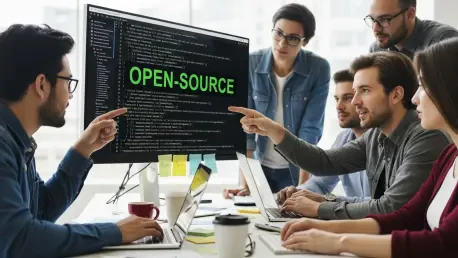The open-source software ecosystem, a vital backbone of modern digital infrastructure, faces a growing crisis as volunteer-driven projects struggle under the weight of corporate expectations, raising urgent questions about sustainability. Consider the staggering reality that tools like FFmpeg, which power video streaming for billions of users on platforms like YouTube, often rely on unpaid labor with minimal financial backing. This disparity prompts a critical question: can tech giants continue to leverage these essential resources without stepping up to fund them? This roundup gathers insights from various industry voices, security experts, and community advocates to explore the sustainability of open-source projects in a corporate-dominated landscape, comparing differing views on funding, responsibility, and collaboration.
The Funding Conundrum: Who Should Bear the Cost?
A significant point of contention in the open-source debate centers on financial support, with many community members highlighting the stark imbalance between usage and contribution. Industry observers note that while trillion-dollar corporations reap enormous benefits from tools like FFmpeg, the projects themselves often scrape by with donations or sporadic grants. This gap leaves maintainers grappling with basic operational needs, unable to scale efforts to match the demands of global usage.
Contrasting this view, some corporate representatives argue that their role is not to directly fund every project but to contribute through other means, such as identifying vulnerabilities or offering patch reward programs. However, critics within the developer community point out that such initiatives often fall short, providing limited support that fails to address the systemic lack of resources. The ethical dilemma of profiting from free software without proportional investment remains a hotly debated issue.
A third perspective comes from nonprofit organizations focused on digital infrastructure, which emphasize the need for structured funding models. Suggestions include creating industry-wide consortiums where tech giants pool resources to support critical open-source tools. This approach, advocates argue, could distribute the financial burden more equitably, ensuring that no single project collapses under neglect.
Corporate Security Policies: Burden or Benefit?
Disclosure Deadlines: A Race Against Time
Security disclosure policies, particularly those enforced by large tech entities, have sparked heated discussions among open-source contributors. Many maintainers express frustration over strict timelines, such as 90-day public disclosure rules, which they view as unrealistic given their limited capacity. The pressure to patch vulnerabilities quickly often diverts attention from other essential development tasks.
On the flip side, security teams from major corporations defend these policies as vital for protecting the broader digital ecosystem. They contend that timely disclosures push for rapid fixes, preventing potential exploitation by malicious actors. This urgency, they argue, justifies the rigid frameworks, even if they strain volunteer resources.
A balanced viewpoint emerges from independent cybersecurity analysts who suggest that disclosure policies should be paired with direct support. Rather than simply reporting issues, corporations could offer technical assistance or temporary funding to help maintainers meet deadlines. This collaborative approach, they believe, could mitigate tension while maintaining a focus on user safety.
AI-Generated Reports: Efficiency or Overload?
The integration of AI tools in vulnerability detection has added another layer of complexity to the open-source landscape. Community feedback often highlights the downside of such automation, with maintainers receiving a flood of reports, many of which are trivial or irrelevant. This influx consumes valuable time, detracting from more pressing priorities.
Corporate proponents of AI-driven security tools argue that automation enhances efficiency, uncovering flaws that might otherwise go unnoticed. They point to the potential for these systems to protect vast user bases by identifying risks at scale. Yet, this perspective often overlooks the human cost on the receiving end of these automated processes.
A nuanced opinion from tech policy experts calls for refining AI tools to prioritize significant threats over minor issues. By filtering out low-impact reports, corporations could reduce the burden on maintainers while still leveraging technology for security. This middle ground seeks to align corporate innovation with the practical realities of volunteer-driven projects.
Maintainer Burnout: The Human Cost of Open-Source
The toll of maintaining open-source software is a recurring theme across discussions, with burnout emerging as a critical concern. Community forums are filled with stories of developers stepping away from projects due to overwhelming workloads, a trend that threatens the stability of essential tools. The lack of resources exacerbates this personal strain, leaving many feeling unsupported.
Security advocates offer a differing lens, stressing that the rapid pace of digital threats necessitates constant vigilance, even at the expense of maintainer well-being. They argue that the broader internet’s safety depends on sustained efforts, urging quicker responses to identified risks. This stance, however, often sidesteps the question of who should provide the necessary support for such efforts.
Insights from mental health professionals in the tech space underscore the need for corporate accountability in addressing burnout. Recommendations include sponsored developer programs or sabbaticals funded by tech giants to give maintainers a reprieve. Such measures could help retain talent and prevent the loss of critical expertise in the open-source realm.
Pathways to Sustainability: Collaborative Solutions
Exploring potential solutions, a variety of voices agree on the urgency of bridging the gap between corporate interests and open-source needs. Proposals often center on establishing dedicated funds or endowments managed by neutral bodies to support widely used projects. This system could ensure consistent resources without reliance on sporadic corporate goodwill.
Another angle comes from grassroots developer networks, which advocate for policy changes within tech companies to prioritize direct contributions over mere reporting. Adjusting security disclosure timelines to account for volunteer constraints is frequently cited as a practical step. This shift could foster a more cooperative dynamic, easing the pressure on maintainers.
A broader industry perspective emphasizes the role of public awareness in driving change. Encouraging end-users and smaller businesses to contribute through donations or advocacy could complement corporate efforts. This collective approach, many believe, is essential to creating a sustainable ecosystem where open-source software thrives without the constant risk of collapse.
Reflecting on Shared Insights and Next Steps
Looking back, the roundup of perspectives revealed a complex interplay of challenges and potential resolutions surrounding open-source sustainability. The discussions underscored a shared recognition that the current model, heavily reliant on volunteer labor, falters under corporate expectations and security demands. Differing views on funding, AI tools, and disclosure policies highlighted the need for tailored strategies that respect both maintainer capacity and digital safety imperatives.
Moving forward, actionable steps emerged as a focal point for all stakeholders. Tech giants were urged to lead by example, establishing robust funding mechanisms and revising security practices to support rather than burden maintainers. Community members and users alike were encouraged to explore avenues for contribution, whether through financial support or advocacy for policy reform. Further exploration of industry reports and open-source foundation resources was recommended to deepen understanding and drive collective action toward a balanced, resilient digital infrastructure.









